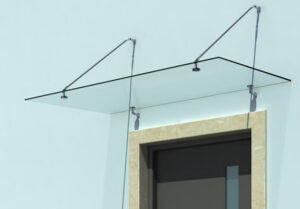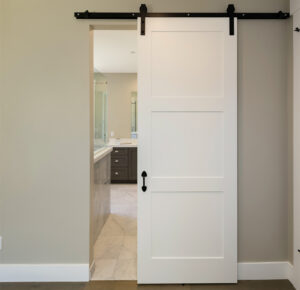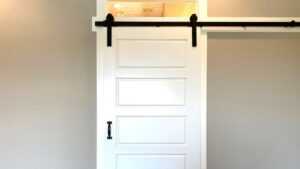If you have a pocket door in your home that slides open without the ability to lock it, you may be looking for simple solutions to secure the room when needed. Fortunately, there are some low-cost DIY options you can use to lock a pocket door without an actual lock.

Whether you need to baby-proof a nursery or just want to prevent accidental openings, being able to lock a pocket door is important. However, permanently installing a new lock can be an involved process that requires drilling and modifications. This article will explore some no-drill methods you can easily employ to lock a pocket door without any permanent changes or complex installations. We’ll cover simple door stops, door wedges, clasps, and hasps that allow you to secure the door with basic hardware often already in your home.
Understanding Pocket Doors
Pocket doors are sliding barn doors that disappear into a compartment in the adjacent wall when opened. They are a space-saving solution and can be found commonly used as doors from the inside, particularly in areas where saving space is essential, like bathrooms and bedrooms. Unlike traditional hinged doors, pocket doors glide along a track that is installed inside the door jamb at the top.
When considering privacy and convenience, pocket doors offer a unique advantage. Their sleek design allows for full use of the space around the door, making them ideal for tight quarters where a swinging door is impractical. Here’s a little breakdown of their major components:
- Door Jamb: The vertical sections on each side of the door where the track is typically concealed.
- Track: The horizontal fixture that holds and guides the door as it slides into the wall cavity or “pocket.”
Notably, pocket door hardware is different from that of traditional doors. The locking mechanism, if present, is usually a small, circular notch that you slide to lock and unlock the door, providing extra privacy, especially in areas like bathrooms.
One of the most common reasons for wanting to secure a pocket door is to provide an additional layer of security against intruders. Pocket doors are often easily accessed from either side, making them vulnerable to intruders who could enter the room.
Maintenance of pocket doors is important to ensure smooth operation. Keep the track and rollers clean and periodically check for any hardware that may become loose over time.
In summary, pocket doors are an excellent choice for adding style and functionality to your home, especially when you’re working with limited space. Their discreet design and efficient use of space make them an appealing option for modern living.
Lock a Door Without a Key
When you’re in a pinch and need to secure your door without a traditional pocket door lock, numerous alternative methods can provide a satisfactory level of security. Each approach offers different benefits, and depending on your situation, one may suit your needs more than the others.
In this section, we will provide you with ways to lock a door without a key.
Door Barricades
Barrier Protection: Use a floor barricade or security bar as a robust barrier against an opening door. Simply place the bar diagonally from the bottom of the door to the floor, creating an immovable force due to the laws of physics. Similarly, a floor barricade that attaches to the floor can block the door from sliding open.
Using Door Jammers
Enhanced Security with Door Jammers: A door jammer is a convenient tool you can use to prevent your door from moving. Place a door jammer firmly under the door where it meets the floor to add an additional layer of security. Jammers can be particularly effective as they are portable and easy to use.
Slide Bolts and Latches
Bolt and Latch Installation: For a more permanent solution, install a sliding bolt lock or latch mechanism. You’ll need to attach the bolt to the door and frame using screws, allowing you to manually slide the bolt into place, securing the door.
Hook and Eye Latches
Simple and Reliable: A hook and eye latch is a cost-effective way to lock a pocket door. This method involves mounting a hook on the door and an eye latch on the frame or wall so that when the hook is inserted into the eye, the door is secured.
Makeshift Locking Methods
DIY Solutions:
- Fork: Bend the prongs of a fork to fit into the strike plate, and insert the handle into the hole to prevent the door from moving.
- Rope or Belt: Tie a rope or belt around the door handle and anchor it to a nearby sturdy object to restrict movement.
- Rubber Bands: For a temporary and light barrier, rubber bands can be looped around the handles on both sides of the door.
- Cardboard: Wedge folded cardboard beneath the door to keep it from sliding open.
Utilizing Existing Furniture
To create a temporary barrier, you can use furniture that’s already in your home.
- Chairs: Turn a chair on its side and wedge it under the door handle. Ensure the chair back is sturdy enough to resist being pushed down.
- Floor Barricades: Arrange heavy furniture in a line against the door. Items like bookshelves or a chest of drawers can act as a substantial barricade.
Remember the goal is to create an obstacle that makes opening the door from the other side challenging.
Security Add-Ons and Enhancements to Secure a Door

When looking to enhance the security of your pocket door without a traditional lock, a range of accessories and measures can be integrated easily. These are designed to add layers of protection, ensuring privacy and safety.
Door Accessories
Chain Lock or Door Chain: A door chain can be a simple addition to your pocket door, acting as a secondary barrier. Attach the chain assembly to the door frame and the chain to the door itself, allowing you to open the door slightly while still keeping it secured.
Magnetic Catch: This device uses magnets to keep the door closed. Affix one part to the door and the corresponding magnet to the frame for a secure fit.
Additional Security Measures
Security Bar: A removable security bar can be placed in the track of the sliding door, preventing it from being opened from the outside. Opt for a bar that fits snugly to maximize security.
Automatic Door Closer: While not a lock, an automatic door closer ensures that your pocket door remains closed when not actively used, which can deter unauthorized entry.
Metal Plate Reinforcement: Reinforce the door with a metal plate where the lock or bolt engages. This metal plate can provide additional resistance against forced entry.
By incorporating these accessories and security measures, you enhance the safety of your pocket door effectively without the need for a traditional lock.
Cost and Budget Considerations
When contemplating your home security without a traditional lock, it’s crucial to balance cost with it. Here’s a breakdown to help you plan your budget:
| Option | Cost | Security Level | Details |
|---|---|---|---|
| Adhesive Hooks and Eye Latch | Very Low | Moderate | – Affordable parts and easy DIY installation – Provides moderate security |
| Adhesive Tape/Sticky Pads | Lowest | Low | – Cheapest option – Temporary and least secure – more for privacy |
| Door Chain | Low to Moderate | Moderate | – Installs for low cost – Allows door to open partially – Moderate security layer |
| Belt or Rope | Minimal | Low | – Uses items already in the home – No cost, but basic security |
| Security Bar | Moderate | High | – More expensive – High security level |
| Portable Door Locks | Moderate | High | – Moderate price – Excellent security |
| Automatic Door Closer | Higher | Enhances Security | – Higher cost – Must combine with other methods for security – Automates closing |
| Magnets | Low to Moderate | Low | – Low to moderate cost – Do not provide robust security |
While you may be on a tight budget, it’s essential to decide how much security you need for your home improvement. A hook and eye latch, door chain, or security bar will offer greater peace of mind than adhesive methods. Portable locks strike a balance between affordability and security, making them an excellent middle-ground choice. Although not a lock, an automatic door closer can prevent your pocket door from being left open inadvertently. Remember, the level of security directly correlates with the price — choose what suits your needs and budget best.
Installation Tips for Pocket Door
For any form of security enhancement to your pocket door installed properly, like a strike plate or a door closer, always begin with reading the manufacturer’s instructions. DIY solutions can be straightforward if you follow these steps closely and gather the necessary tools beforehand.
Tools You Might Need:
- Screwdriver
- Drill (for pilot holes)
- Measuring tape
- Level
For a strike plate lock installation:
- Align the strike plate with the latch mechanism’s position.
- Mark the screw positions with a pencil.
- Pre-drill pilot holes to avoid splitting your door frame.
- Fasten the strike plate using the screws provided.
Door closers are a bit more complex, mainly if your door is an exterior pocket door, and may require professional installation for optimal functionality and safety.
Frequently Asked Questions
Can you use a portable lock to secure a pocket door from the outside?
Yes, portable locks can be used to secure a pocket door from the outside. These devices are designed to be versatile and can often be adapted to different door types, including pocket doors.
What are some temporary locking solutions for a pocket door?
For a temporary solution, consider using a hook and eye latch, a door chain, or a wedge inserted at the base of the door. These options can provide a temporary barrier without permanent alterations.
Is it feasible to install a lock on a previously non-lockable pocket door?
Installing a lock on a pocket door that previously didn’t have one is certainly an option. Hardware stores offer pocket door latch kits that can be installed with some basic tools.
How can you creatively use household items to lock a pocket door?
Get creative by using items like a belt or loop of rope to secure your pocket door handles together, preventing the door from sliding open.
What are the methods for locking a bedroom pocket door from the outside without drilling?
You can use a surface-mounted sliding door lock or adhesive locks that attach without drilling. These methods ensure the door remains shut from the outside while not damaging the door’s surface.
How can you secure a sliding pocket door using a chair?
If the pocket door slides into a wall on one side, you can place a chair underneath the door handle in such a way that it braces against the handle and the opposite wall, creating an improvised lock.
How Do I Know If My Pocket Door Is Securely Locked?
To ensure your pocket door is securely locked, first visually inspect the latch to make sure it is fully engaged and firmly in place. If using a sliding bolt, deadbolt, or other secondary lock, check that the locking mechanism is properly aligned and tightened with screws.
You should also examine the door frame and jamb to confirm screws and other hardware are correctly installed for optimum security. Additionally, if a supplementary lock like a chain or guard is installed, verify it is functioning as expected.
Finally, look at the exterior side of the door to ensure all locks and latches are completely secured. Properly installed pocket door locks that are fully engaged provide reliable security.
However, you should periodically inspect them to ensure the latch catch plate is free of wear and continues functioning smoothly. Replacing loose screws or worn parts promptly can prevent future issues with keeping the door securely locked.






